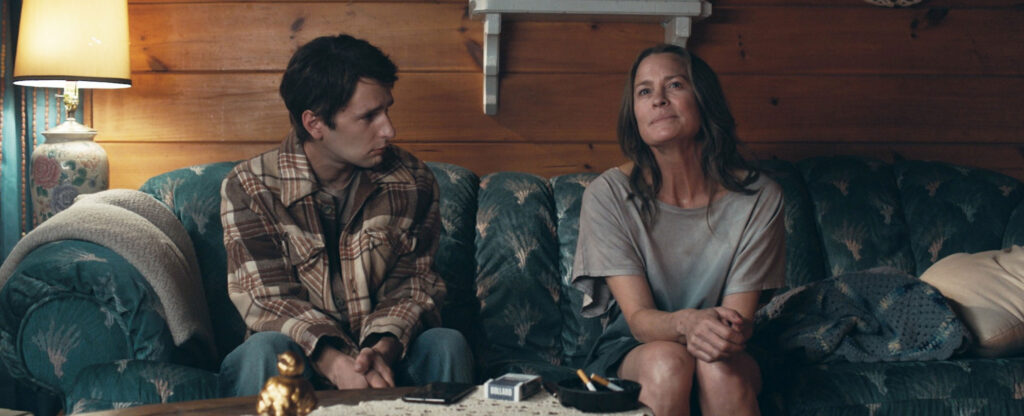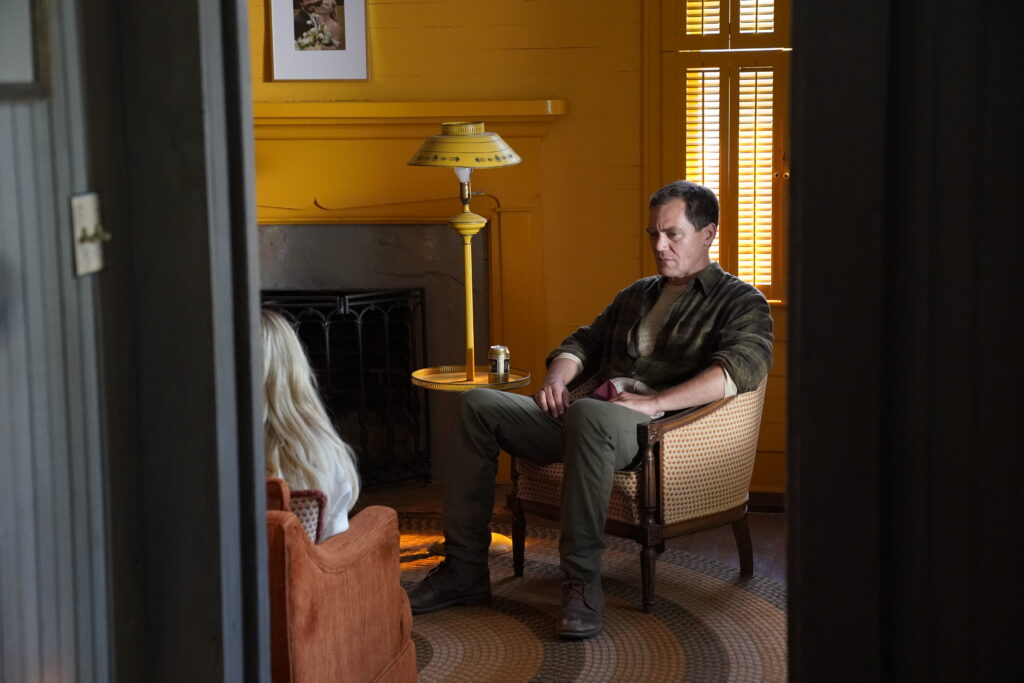January 2, 2024
by Carla Hay

Directed by James Rowe
Culture Representation: Taking place in North Carolina and in Virginia, the dramatic film “Breakwater” features a predominantly white cast of characters (with some African Americans) representing the working-class and middle-class.
Culture Clash: An ex-con tracks down the estranged daughter of a fellow prisoner as a favor but finds out that this favor is not what it appears to be.
Culture Audience: “Breakwater” will appeal primarily to people who don’t mind watching predictable and not-very-believable crime thrillers.

“Breakwater” starts off being a mediocre thriller, but then it goes swiftly downhill in the last third of the movie, when it crams in too many far-fetched plot twists. It doesn’t help that the movie’s protagonist is dimwitted and boring. Unfortunately, the trailer for “Breakwater” reveals about 85% of what happens in the last third of the movie, including a few of the plot twists that should be surprises. Therefore, anyone who sees the trailer before watching “Breakwater” will be even more bored, because of the long and often tedious wait to get to the expected climactic showdown.
Written and directed by James Rowe, “Breakwater” had the potential to be a much better film if it hadn’t relied so much on tiresome clichés. The movie is also plagued by mediocre-to-bad performances from many of the principal cast members. The “hero” and the “villain” in the story have one-dimensional personalities. It all adds up to a frequently flat cinematic experience that becomes the most cringeworthy in the last third of the movie.
“Breakwater” centers on a gullible young man named Dovey (played by Darren Mann, giving a very stiff performance), who was sent to a Virginia prison for drug possession. (“Breakwater” was actually filmed in North Carolina.) Viewers find out later that Dovey took the blame for the crime, in order to protect the guilty woman whom he didn’t want to go to prison. It’s an example of how Dovey is overly generous and can be taken advantage of by the wrong people.
In the beginning of the movie, Dovey is spending his last day in prison before he is released. A fellow inmate named Ray Childress (played by Dermot Mulroney) has somehow gotten a slice of cake inside a cell and gives it to Dovey as a “birthday” present, because Ray says that getting out of prison is a rebirth. Ray asks Dovey for a big favor when Dovey is out of prison: Ray wants Dovey to find his estranged adult daughter Marina, who hasn’t seen or spoke to Ray in about seven years.
Ray has an idea where Marina is because he saw a woman who looks just like her in a newspaper photo published with a story about the mast of a 19th century ship being found off the coast of North Carolina. The mast is still standing upright in the ocean before it will be transported somewhere to be examined. Marina was one of the onlookers in the photo.
Ray says that if Dovey finds Marina, then Dovey cannot tell Marina that Ray is looking for her. Ray also says he just wants Dovey to tell him where Marina lives or works and if Marina is doing okay. Dovey agrees to do this favor out of the goodness of his heart and because he respects Ray, who became his friend in prison. Dovey doesn’t expect anything in return.
Even though Mena Suvari is a headliner for this movie, she has a useless cameo that lasts for less than five minutes. She portrays a bartender named Kendra, who has a thing for ex-cons and tries to seduce Dovey soon after he gets out of prison and he becomes a customer in the bar where she works. Their brief encounter ends awkwardly when Dovey doesn’t go for Kendra’s kink of having an ex-con pretend to kill her while having sex.
Before going to North Carolina’s Outer Banks, where Marina is believed to be living, Dovey goes home to spend time with his fisherman father Luther (played by J.D. Evermore), whose specialty is crab fishing. Luther is happy to have Dovey working with him again on Luther’s small fishing boat. However, Dovey doesn’t stay for very long before he hops on his motorcycle to go to North Carolina to find Marina.
It should come as no surprise that Dovey finds her, except she is now going by the name Eve (played by Alyssa Goss), and she is the single mother of a daughter named Harper (played by Ezra DuVall), who’s about 5 or 6 years old. Harper and Eve live with Eve’s roommate Jess (played by Celia Rose Gooding), a pop/R&B singer who gets gigs at local restaurants/bars. “Breakwater” barely shows what kind of mother Eve is until the problematic last third of the movie.
Eve, who is friendly but foul-mouthed in her personal life, seems to be financially struggling. She is juggling jobs at a bookstore and as a tour guide for Outer Banks historical locations. Dovey charms Eve when they first meet by telling her that they share a passion for ships and sea history. He also tells her that he grew up spending a lot of time in the water. Dovey and Eve’s attraction to each other goes exactly where you think it will go.
Eve decides to take Dovey to a rocky coast area so he can get a better look at the mast from the 19th century shipwrecked boat. She accidentally drops a bracelet that she says was given to her by her father. The bracelet has sunk into the water, but Dovey decides he’s going to be a gallant gentleman, so he dives in the water to retrieve the bracelet and gives it back to Eve, who is flattered by and grateful for this kind gesture. Dovey later describes the bracelet to Ray in a phone conversation, which is how Ray knows that Dovey found the right person.
Of course, since it was already revealed in the movie’s trailer, Ray has sinister reasons to find Eve. Dovey’s no-nonsense parole officer Bonnie Bell (played by Sonja Sohn) becomes involved in this mess when she finds out that Dovey has violated his parole by crossing state lines without permission. It all leads to a very hokey conclusion with ridiculous-looking action scenes and plot “reveals” that sink the movie faster than you can say “forgettable, low-quality movie.”
Vertical released “Breakwater” in U.S. cinemas, digital and VOD on December 22, 2023.






